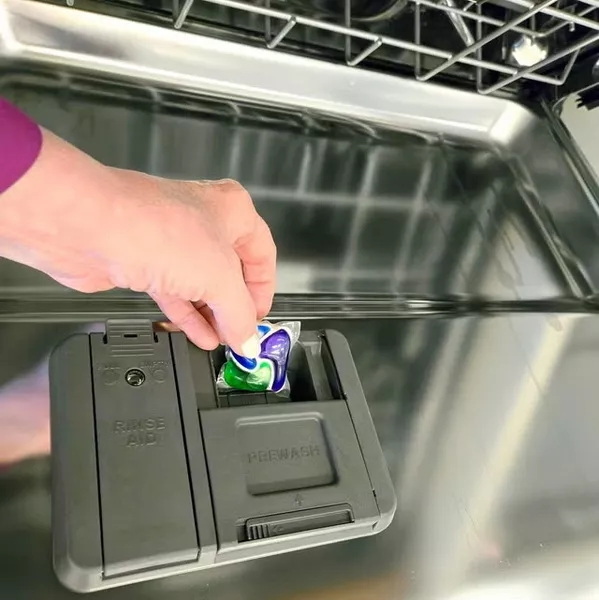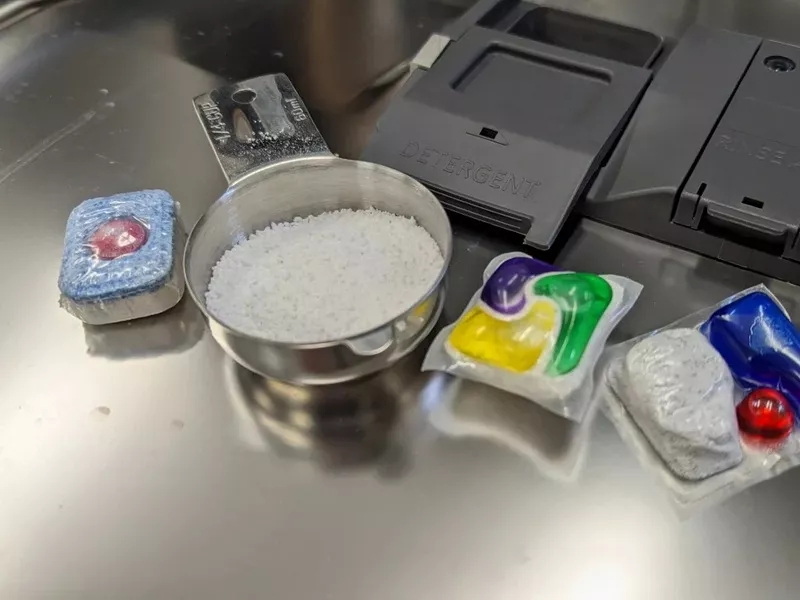Dongguan UFine Daily Chemical Co.,Ltd.
- All
- Product Name
- Product Keyword
- Product Model
- Product Summary
- Product Description
- Multi Field Search
Views: 222 Author: Tomorrow Publish Time: 11-28-2025 Origin: Site











Content Menu
● Understanding Dishwasher Pods
● Can Older Dishwashers Use Pods?
● Key Considerations for Using Pods in Older Dishwashers
● Advantages of Using Pods in Older Dishwashers
● Potential Problems with Pods in Old Dishwashers
● How to Use Pods Effectively in Older Dishwashers
● Alternative Dishwasher Detergent Options
● Extending the Life of an Older Dishwasher
● Environmental and Cost Considerations
● The Future of Dishwasher Detergents
● FAQ
>> 1. Can I place the pod at the bottom of my old dishwasher?
>> 2. What water temperature works best for pods in older dishwashers?
>> 3. Why do pods sometimes leave residue in my old dishwasher?
>> 4. Are pods safe for all dishwasher brands?
>> 5. Should I use rinse aid with pods in an old dishwasher?
Modern detergent pods have become a popular choice for their convenience and cleaning efficiency, but many homeowners with older dishwashers wonder whether these modern cleaning products are compatible with their aging appliances. Detergent pods promise powerful cleaning without measuring or mess, yet the question remains: can older dishwashers use pods without causing performance issues or damage? This article explores the compatibility, pros and cons, and practical advice for safely using pods in older dishwasher models.

Dishwasher pods, also known as tablets or packs, are pre-measured doses of concentrated detergent encased in a dissolvable film. The film dissolves in water during the wash cycle, releasing detergent, rinse aid, and sometimes enzymes for effective cleaning. Unlike traditional powder or liquid detergent, pods simplify the cleaning process by removing guesswork and ensuring consistent detergent amounts.
Dishwasher pods are engineered for high-efficiency dishwashers, which use sensors and optimal water temperature for dissolving the pod's outer film. This precise design raises questions about whether older dishwashers, which use different washing methods, have the necessary water pressure, spray coverage, or temperature to properly dissolve and use pods.
Older dishwashers, particularly those made before the mid-2000s, often operate with different water heating and detergent-release designs compared to modern models. They may rely on:
- Manual setting control for wash cycles
- Lower water temperature or less consistent heating
- A non-sealed detergent cup unsuitable for modern pods
- Weaker spray arms or restricted water distribution
These design factors can affect how efficiently a detergent pod dissolves. If the water never reaches the optimal dissolving temperature — typically above 120°F (about 49°C) — pods may fail to break down fully, leaving behind detergent residue, film, or undissolved chunks.
The short answer is yes, older dishwashers can use pods, but with caution and some adjustments. Proper dissolution and performance depend on water temperature, spray pressure, and detergent dispenser design. If these factors are properly managed, pods can work effectively even in older machines.
Pods need hot water to dissolve completely. Run your sink tap until the water feels hot before starting the dishwasher. This ensures the first water filling the machine is already warm enough to activate the pod.
Some older dishwashers have smaller or shallower detergent cups. If the pod doesn't fit snugly, it may get stuck when the dispenser opens. Placing the pod at the bottom of the dishwasher instead of the dispenser can help.
Choose a longer and hotter cycle rather than quick or energy-saving modes. These faster cycles might not allow enough time or heat for the pod to dissolve fully.
Over time, older dishwashers can lose water pressure due to clogging or calcium buildup in spray arms. Cleaning these components ensures even distribution, helping pods dissolve evenly.
Routine cleaning of filters and spray arms greatly improves overall detergent efficiency. Undissolved detergent residues or hard-water deposits can impair performance, especially when using pods.

Despite potential limitations, pods offer several advantages even for older machines when used correctly.
- Convenience and Consistency: Pods eliminate the need to measure powder or liquid detergent, offering precise dosing every time.
- Reduced Detergent Waste: Each pod is pre-portioned, preventing overuse that can lead to excessive suds or buildup.
- Improved Cleaning Efficiency: High-quality pods include enzymes and rinse aids to remove grease and prevent spotting, potentially improving cleaning quality even in older dishwashers.
- Compact Storage and Less Mess: Pods save space and prevent spills, which makes them easy to store and handle.
While pods can work, certain issues may arise if conditions are not ideal.
- Incomplete Dissolution: Low water temperature is the primary problem, causing leftover detergent residue or plastic film.
- Detergent Cup Blockage: Large pods may not fit old-style dispensers and can jam them.
- Foam Residue or Cloudiness: Hard water or incompatible rinse cycles can lead to spotting or residue if the pod's formulation mismatches the dishwasher's design.
- Build-Up in Filters: If undissolved pod material reaches the filter, it can cause clogging over time, reducing cleaning effectiveness.
To ensure your older dishwasher performs well with pods, follow these practical tips:
- Run the Tap First: Hot starting water ensures the pod dissolves quickly and completely.
- Use the Hot or Heavy Cycle: These cycles maintain optimal water temperature and duration for pod effectiveness.
- Place Pod Properly: If the dispenser is unsuitable, put the pod in the bottom rack of the dishwasher before starting it.
- Clean Regularly: Remove detergent buildup, check spray arms for blockages, and descale your dishwasher monthly.
- Test Different Brands: Some pods dissolve faster than others. Experiment to find one that works best with your machine.
- Avoid Old or Damp Pods: Fresh pods dissolve better. Store them in a cool, dry place away from humidity.
Following these guidelines often resolves most pod-related issues in older machines, allowing users to enjoy modern cleaning performance without replacing their appliance.
If pods prove inconsistent with your older machine, consider other detergent types:
- Powder Detergent: Traditional and reliable, powder formulations dissolve easily and work well in older dishwashers.
- Liquid Gel: Easier to dissolve than pods, liquid detergent can adapt to varying wash conditions.
- Homemade Detergents: Some users mix baking soda, washing soda, and a bit of dish soap, though this requires care to avoid oversudsing.
Each detergent type has its strengths. Older machines typically perform best with powder or gel detergents designed for standard water temperatures.
Avoid using pods in these situations:
- Low Water Temperature Systems: If your dishwasher doesn't have an internal water heater or uses a cold-only hookup.
- Partial Dispenser Failure: A broken detergent door may cause the pod to fall out too soon or get stuck.
- Hard Water Conditions Without Rinse Aid: Pods with built-in rinse aids may not be enough to prevent spotting.
- Excessive Residue History: If pods consistently leave film or residue, they may not be compatible with your model.
In such cases, switching to traditional detergent often resolves the problem instantly.
If you plan to continue using your older dishwasher, combining good maintenance with the right detergent choice is essential.
- Inspect and clean the filter monthly.
- Descale using vinegar or a dishwasher cleaner every few months.
- Check hose connections and gaskets for leaks.
- Maintain proper loading techniques to promote even spray distribution.
- Run periodic empty cycles with citric acid to reduce buildup.
Proper care extends performance, letting you benefit from modern detergent types without needing immediate appliance replacement.
While pods offer convenience, they are often more expensive per load than powder or liquid detergents. Additionally, some pods include chemicals and packaging materials with environmental impacts. Older dishwashers may require hotter or longer cycles with pods, raising energy use and cost over time. For environmentally conscious users, powder detergents or eco-friendly liquid detergents with biodegradable packaging might be preferable.
As more households transition to energy-efficient dishwashers, detergent technology continues to evolve. Manufacturers now design pods adapted for lower water usage, faster cycles, and different temperature requirements. Some brands market universal pods suited for both newer and older dishwashers, featuring faster-dissolving films and milder formulas. This innovation reduces compatibility challenges for older models.
Older dishwashers can use pods effectively with the right precautions. Ensuring hot water, proper cycle choice, and regular maintenance helps the detergent dissolve completely and prevent residue. However, users should pay attention to their machine's limitations and adjust their detergent choices accordingly. When used correctly, pods can be a convenient and effective solution for achieving spotless dishes, even in an aging dishwasher.

Yes. If your dispenser is too small or the pod tends to get stuck, placing it at the bottom rack before starting the cycle ensures full dissolution.
Water temperatures around 120°F (49°C) or higher are ideal for pod dissolution. Run your kitchen tap until hot before starting the cycle.
Residue often results from low water temperature, blocked spray arms, or incomplete pod dissolution. Cleaning the machine or using a longer cycle helps.
Yes, most commercial pods are compatible across brands, but check your manufacturer's guidelines if you have an older or specialty model.
Yes. Even if pods contain rinse aids, adding a bit more can prevent glassware spots, especially if you have hard water.
[1](https://www.ufinechem.com/can-you-use-dishwasher-pods-in-an-older-dishwasher.html)
[2](https://tru.earth/blogs/tru-living/how-to-solve-common-issues-with-dishwasher-detergent-pods)
[3](https://automaticwasher.org/threads/liquid-detergents-or-pods-in-old-dishwashers.87128/)
[4](https://www.maytag.com/blog/kitchen/how-to-use-dishwasher-pods.html)
[5](https://www.everydaycheapskate.com/how-to-make-even-an-elderly-dishwasher-perform-like-new/)
[6](https://www.ufinechem.com/can-i-use-detergent-pods-in-older-dishwashers.html)
[7](https://products.geappliances.com/appliance/gea-support-search-content?contentId=17469)
[8](https://www.reddit.com/r/Frugal/comments/6mu4cv/detergent_for_old_dishwasher/)
[9](https://lakeappliancerepair.com/blog/detergent-not-dissolving-in-the-dishwasher/)
[10](https://www.ufinechem.com/can-any-dishwasher-use-pods.html)